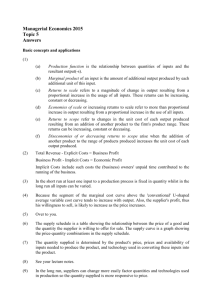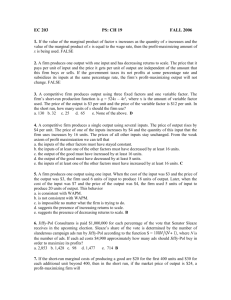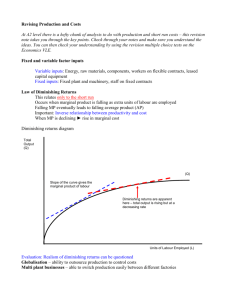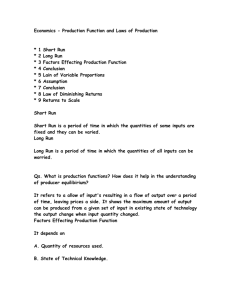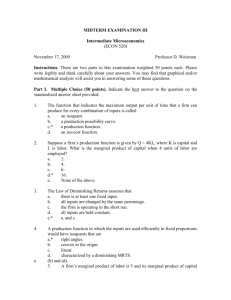Theory Production and Cost 22.01.12
advertisement
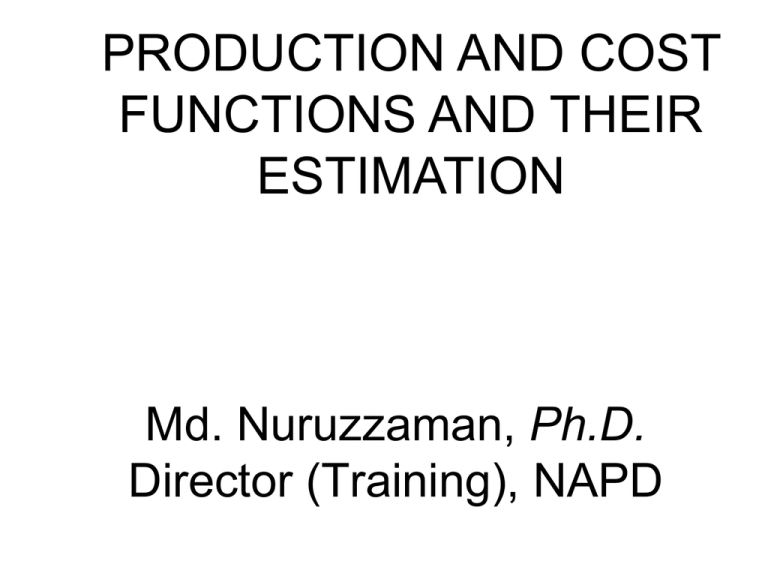
PRODUCTION AND COST FUNCTIONS AND THEIR ESTIMATION Md. Nuruzzaman, Ph.D. Director (Training), NAPD PRODUCTION FUNCTION A table, graph, or equation showing the maximum output rate of the product that can be achieved from any specified set of usage rates of inputs Introduction To Production Function Theory • Production function is the relation between input and output. • Production function is the name given to the relationship between the rates of input of productive services and the rate of output of a product. • Thus, the production function expresses the relationship between the quantity of output and the quantities of various inputs used for the production. The Concept Of A Production Function • The production function is a mathematical expression which relates the quantity of factor inputs to the quantity of outputs that result. We make use of three measures of production / productivity. • Total product is simply the total output that is generated from the factors of production employed by a business. In most manufacturing industries such as motor vehicles, freezers and DVD players, it is straightforward to measure the volume of production from labor and capital inputs that are used. But in many service or knowledgebased industries, where much of the output is “intangible” or perhaps weightless we find it harder to measure productivity The Concept Of A Production Function • Average product is the total output divided by the number of units of the variable factor of production employed (e.g. output per worker employed or output per unit of capital employed) • Marginal product is the change in total product when an additional unit of the variable factor of production is employed. For example marginal product would measure the change in output that comes from increasing the employment of labour by one person, or by adding one more machine to the production process in the short run. Production Function Amount of Labor (annual # units) 1 2 3 4 5 6 7 8 Output of Parts (hundreds/year) 12 27 42 56 68 76 76 74 AP Labor 12.0 13.5 14.0 14.0 13.6 12.7 10.9 9.3 MP Labor 1 15 15 14 12 8 0 -2 Production Function Parts 80 60 40 20 0 0 2 4 6 Labor 8 10 Production Function 20 Parts 15 10 AP Labor 5 MP Labor 0 -5 0 5 Labor 10 The Short Run Production Function • The short run is defined in economics as a period of time where at least one factor of production is assumed to be in fixed supply i.e. it cannot be changed. • We normally assume that the quantity of capital inputs (e.g. plant and machinery) is fixed and that production can be altered by suppliers through changing the demand for variable inputs such as labor, components, raw materials and energy inputs. • Often the amount of land available for production is also fixed. • The time periods used in textbook economics are somewhat arbitrary because they differ from industry to industry. The Short Run Production Function • The short run for the electricity generation industry or the telecommunications sector varies from that appropriate for newspaper and magazine publishing and small-scale production of foodstuffs and beverages. • Much depends on the time scale that permits a business to alter all of the inputs that it can bring to production. • In the short run, the law of diminishing returns states that as we add more units of a variable input (i.e. labor or raw materials) to fixed amounts of land and capital, the change in total output will at first rise and then fall. • Diminishing returns to labor occurs when marginal product of labor starts to fall. The Short Run Production Function • This means that total output will still be rising – but increasing at a decreasing rate as more workers are employed. As we shall see in the following numerical example, eventually a decline in marginal product leads to a fall in average product. • What happens to marginal product is linked directly to the productivity of each extra worker employed. • At low levels of labor input, the fixed factors of production - land and capital, tend to be under-utilized which means that each additional worker will have plenty of capital to use and, as a result, marginal product may rise. • Beyond a certain point however, the fixed factors of production become scarcer and new workers will not have as much capital to work with so that the capital input becomes diluted among a larger workforce. • As a result, the marginal productivity of each worker tends to fall – this is known as the principle of diminishing returns. Law of Diminishing Marginal Returns If equal increments of an input are added to a production process, and the quantities of other inputs are held constant, eventually the marginal product of the input will diminish Note: 1) This is an empirical generalization. 2) Technology remains fixed. 3) The quantity of at least one input is held fixed. Law of Diminishing Marginal Returns • An example of the concept of diminishing returns is shown here. We assume that there is a fixed supply of capital (e.g. 20 units) available in the production process to which extra units of labor are added from one person through to eleven. • Initially the marginal product of labor is rising. • It peaks when the sixth worked is employed when the marginal product is 29. • Marginal product then starts to fall. Total output is still increasing as we add more labor, but at a slower rate. At this point the short run production demonstrates diminishing returns. • Average product will continue to rise as long as the marginal product is greater than the average – for example when the seventh worker is added the marginal gain in output is 26 and this drags the average up from 19 to 20 units. • Once marginal product is below the average as it is with the ninth worker employed (where marginal product is only 11) then the average will decline. The Law of Diminishing Returns Capital Input Labor Input Total Output Marginal Product Average Product of Labor 20 1 5 20 2 16 11 8 20 3 30 14 10 20 4 56 26 14 20 5 85 28 17 20 6 114 29 19 20 7 140 26 20 20 8 160 20 20 20 9 171 11 19 20 10 180 9 18 20 11 187 7 17 5 Criticisms of the Law of Diminishing Returns • How realistic is this notion of diminishing returns? Surely ambitious and successful businesses do what they can to avoid such a problem emerging. • It is now widely recognized that the effects of globalization, and in particular the ability of trans-national corporations to source their factor inputs from more than one country and engage in rapid transfers of business technology and other information, makes the concept of diminishing returns less relevant in the real world of business. • The expansion of “out-sourcing” as a means for a business to cut their costs and make their production processes as flexible as possible. • In many industries as a business expands, it is more likely to experience increasing returns. After all, why should a multinational business spend huge sums on expensive research and development and investment in capital machinery if a business cannot extract increasing returns and lower unit costs of production from these extra inputs? Long Run Production - Returns To Scale • In the long run, all factors of production are variable. How the output of a business responds to a change in factor inputs is called returns to scale. • Increasing returns to scale occur when the % change in output > % change in inputs • Decreasing returns to scale occur when the % change in output < % change in inputs • Constant returns to scale occur when the % change in output = % change in inputs A numerical example of long run returns to scale Units of Capital Units of Labor Total Output % % Change Change in Inputs in Output Returns to Scale 20 150 3000 40 300 7500 100 150 Increasing 60 450 12000 50 60 Increasing 80 600 16000 33 33 Constant 100 750 18000 25 13 Decreasing Long Run Returns To Scale • In the example above, we increase the inputs of capital and labor by the same proportion each time. We then compare the % change in output that comes from a given % change in inputs. • In our example when we double the factor inputs from (150L + 20K) to (300L + 40K) then the percentage change in output is 150% - there are increasing returns to scale. • In contrast, when the scale of production is changed from (600L + 80K0 to (750L + 100K) then the percentage change in output (13%) is less than the change in inputs (25%) implying a situation of decreasing returns to scale. • As we shall see a later, the nature of the returns to scale affects the shape of a business’s long run average cost curve. •The Effect Of An Increase In Labor Productivity At all levels of employment productivity may have been increased through the effects of technological change; improved incentives; better management or the effects of work-related training which boosts the skills of the employed labor force Two Aspects of Production Function Theory The two aspects which are stressed under production function theory are • Maximum quantity of output can be produced from any chosen quantities of various inputs • Minimum quantities of various input that are required to yield a given quantity of output Three Ways of Production Function Theory • The production function theory can be studied in three ways namely (1) Law of variable proportion where quantities of some factors is kept fixed but the other factors are varied, (2) Laws of Return to Scale where quantities of all factors is varied and (3) Optimum combinations of inputs. Production function can be algebraically expressed as Q=f(N,L,K,T) where Q = quantity of output N , L , K , T = quantités of inputs f = unspecified form of functional relationship between N, L , K and T Practical Importance of Production Function Theory • Production function gives an idea of the optimum level of the output and the optimum employment of the variable inputs. • It tells management the budget constraint for increase in output. • The production function theory explains the degree of substitution of different factors of production. • The management should endeavor to produce an upward shift in production function which can definitely improve its financial performance under the given market conditions. • The theory of production function can also explain the possibility of disguised unemployment. • As production function is an engineering concept, one can study the behavior of production function under different conditions. The Analysis of Costs Opportunity Costs What Does Opportunity Cost Mean? • The cost of an alternative that must be forgone in order to pursue a certain action. • Put another way, the benefits you could have received by taking an alternative action. • The difference in return between a chosen investment and one that is necessarily passed up. • Say you invest in a stock and it returns a paltry 2% over the year. In placing your money in the stock, you gave up the opportunity of another investment - say, a riskfree government bond yielding 6%. • In this situation, your opportunity costs are 4% (6% 2%). Historical Costs The amount the firm actually paid for a particular input Explicit Vs. Implicit Costs • Explicit costs include the ordinary items that an accountant would include as the firms expenses • Implicit costs include opportunity costs of resources owned and used by the firm’s owner Short Run • A period of time so short that the firm cannot alter the quantity of some of its inputs • Typically plant and equipment are fixed inputs in the short run • Fixed inputs determine the scale of the firm’s operation Three Concepts Of Total Costs • Total fixed costs = FC • Total variable costs = VC • Total costs = FC + VC Fixed, Variable And Total Costs OUTPUT 0 1 2 3 4 5 6 7 8 9 10 11 12 FC 2000 2000 2000 2000 2000 2000 2000 2000 2000 2000 2000 2000 2000 VC 0 100 180 280 392 510 650 800 960 1140 1340 1560 2160 TC 2000 2100 2180 2280 2392 2510 2650 2800 2960 3140 3340 3560 4160 dollars Fixed, Variable and Total Costs. 5000 4000 3000 2000 1000 0 FC VC TC 0 10 Units of Output 20 Average And Marginal Costs OUTPUT 0 1 2 3 4 5 6 7 8 9 10 11 12 AFC AVC ATC MC 2000.0 1000.0 666.7 500.0 400.0 333.3 285.7 250.0 222.2 200.0 181.8 166.7 100.0 90.0 93.3 98.0 102.0 108.3 114.3 120.0 126.7 134.0 141.8 180.0 2100.0 1090.0 760.0 598.0 502.0 441.7 400.0 370.0 348.9 334.0 323.6 346.7 100 80 100 112 118 140 150 160 180 200 220 600 $$$ Average And Marginal Costs 2000 1500 1000 500 0 0 2 4 6 8 10 12 Units of output AFC AVC ATC MC Long-run Cost Functions • Often considered to be the firm’s planning horizon • Describes alternative scales of operation when all inputs are variable Average cost Quantity of output Long-run Average Cost Function Shows the minimum cost per unit of producing each output level when any scale of operation is available Average cost SR average cost functions LR average cost Quantity of output Key Steps: Cost Estimation Process Definition of costs Correction for price level changes Relating cost to output Matching time periods Controlling product, technology, and plant Length of period and sample size Minimum Efficient Scale The smallest output at which long-run average cost is a minimum. Average cost Qmes Quantity of output The Survivor Technique • Classify the firms in an industry by size and compute the percentage of industry output coming from each size class at various times • If the share of one class diminishes over time, it is assumed to be inefficient • These firms are then operating below minimum efficient scale Economies of Scope Exist when the cost of producing two (or more) products jointly is less than the cost of producing each one alone. S = C(Q1) + C(Q2) - C(Q1+ Q2) C(Q1+ Q2) Break-even Analysis Dollars Total Revenue Total Cost Profit Loss Quantity of output

